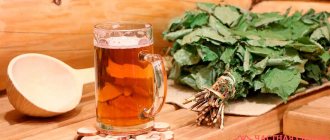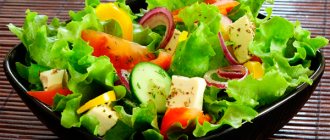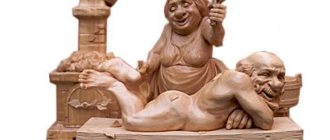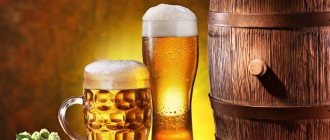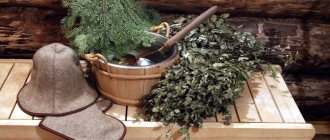What can you eat and drink before the bath?
It’s worth noting right away that it is strongly not recommended to eat before going to the bathhouse - this can significantly damage your health. According to recommendations created in ancient times, you can eat only 4-5 hours before the start of bath procedures. According to other sources, you can eat only 2 hours before going to the bathhouse and 2 hours after.
If you stay in a bathhouse with a full stomach for a long time, then negative consequences cannot be avoided. From an anatomical point of view, this is completely justified: the body, located in a heated steam room, experiences the effects of high temperature, as a result of which the blood approaches the skin, moving away from the internal organs.
Replenishing fluid loss
In order for a visit to a sauna or steam bath to bring benefits and not harm, you need to follow two simple rules:
- eat no later than 2-3 hours before entering the steam room, giving preference to light food;
- Drink enough water and other liquids to stay hydrated.
Restricting food intake is due to the fact that in the heat it is difficult for the organs of the gastrointestinal tract to perform their functions normally. Their blood supply deteriorates, as a large amount of blood rushes to the surface of the skin. As a result, digestion and absorption of food slows down. There is a feeling of heaviness in the stomach and discomfort occurs. This significantly reduces the usefulness of the bath procedure.
Intense loss of fluid without replenishing its reserves leads to problems of a different kind: blood thickening, increased stress on the heart, headaches and even fainting. Therefore, drinking is not only possible, but absolutely necessary. The main thing is to do it correctly.
You should refrain from drinking in the steam room, otherwise more sweat will come out, and the process of cleansing the body will slow down. It is better to quench your thirst after you have sweated well and rested slightly. Water or another suitable drink is not drunk in one gulp, but little by little, preferably warm.
To replenish lost fluid, 1 liter of drinks is enough. A larger amount will result in additional stress on the heart and kidneys. Those who visit the sauna with the goal of losing extra pounds should limit drinking to a minimum.
What can you drink in the bathhouse?
When taking bath procedures, the body loses a considerable part of water. Naturally, it needs to be replaced so that the body can function normally. But deciding what is best to drink in a bathhouse is quite difficult - this question is too individual.
It is much easier to list those drinks that should not be drunk in the bathhouse under any circumstances:
- Alcohol. Drinking alcoholic beverages in a bathhouse can lead to tragic consequences.
- Artificial drinks. There will definitely be no benefit from them, but harm is quite possible.
- Drinks with fillers and additives.
By and large, all such things can be brought to one common denominator. The fact is that any liquid that includes additives is essentially food, and the body will require effort to digest it. This statement applies to everything that is eaten and drunk in the bathhouse - juices, even the weakest ones, carbonated drinks that harm the body when taken in the hot conditions of a steam room, and all other things.
Based on the rules described above, you can come to a fairly obvious conclusion - you need to decide what drinks to drink in the bathhouse individually, depending on the health status of a particular person. For some, berry juice is a good solution, for others, compote or kvass is suitable. Also, don’t forget what to take with you to the bathhouse, in addition to drinks.
However, there is an average solution, and its name is herbal tea. Of course, real tea is also not bad, but infusions made from natural herbs contain much more essential substances that help maintain the necessary balance of enzymes in the body. Herbal tea is the optimal answer to numerous questions about what to drink in a bathhouse for health.
Can beer in a sauna be beneficial?
There is only one way to use foam in a sauna that can add health, and not reduce its reserves. This is the preparation of a special “cocktail” that is poured over the stones.
This mixture should contain 700 ml of beer per liter of water, as well as a teaspoon of honey. First, plain water is poured onto the stones, then this solution, and then water again. Inhaling air saturated with the aroma of yeast has a beneficial effect on metabolism, gently “stimulating” it, stimulating the body’s immune forces.
Beer (if consumed internally) and a sauna are incompatible - this is what doctors say. Are you not convinced by the arguments they give? In this case, you can allow yourself to enjoy beer in the steam room while talking with friends, but be prepared to take responsibility for the possible consequences on yourself.
But maybe a couple of hours of pleasure is not worth serious health problems? Buy yourself a bottle to take home and drink it there when you return from the sauna. It's much more useful!
Tea and coffee in the bathhouse
As for whether it is possible to drink black tea or coffee in a bathhouse, the answer will be: it is not recommended. It's all about caffeine, which is found in large quantities in both coffee and black tea. Taking these drinks in combination with bath procedures can seriously strain the cardiovascular system.
However, there is an interesting recipe for devoted fans of black tea: herbs are added to the tea, which will simultaneously add benefits to the drink and will not detract from its unique taste. Herbal supplements include mint, coltsfoot, chamomile, eucalyptus or currant. St. John's wort, hawthorn or rose hips are used somewhat less frequently - these substances belong to the category of those that need to be drunk in the bathhouse for maximum effectiveness of bathing procedures.
Naturally, you can only use individual parts of plants. For example, in the case of linden, you can use leaves and flowers, raspberries - flowers and leaves, St. John's wort - the flowering part of the stem on which the leaves grow. At the very least, you definitely won’t experience a shortage of natural supplements.
Tea assortment
The best drink to restore water balance is tea. It helps to relax, correct and calm the body.
Making tea is a simple matter. But how to drink it correctly? Between sessions and after the steam room, take small sips. Experienced people advise that a good substitute for sugar in tea is honey or jam. Through trial and error, it was discovered that hot drinks quench thirst better than cold ones. Therefore, warm or hot tea is a normal option. It is also not recommended to drink coffee and other tonic drinks. Because they have a bad effect on the cardiovascular system.
Herbal infusions
Decoctions of various herbs are good to use between sessions and after a bath. Everyone chooses the composition of the decoction according to their own taste, but we also must not forget about the proportions. Dry rose hips with cherry berries, St. John's wort flowers and oregano, brewed with boiling water, will help the body tolerate paired procedures more easily. You can also take various compotes to the bathhouse. Don't forget about the temperature of the drink. It should not be too low.
The infusions are not only drunk, but also poured onto the heater to produce steam. The pleasant aroma of medicinal herbs and berries helps improve the condition of the respiratory tract.
Mineral water
With heavy sweating, in addition to liquid, various salts also come out of the body. It is a good idea to drink mineral water. This drink will help quench your thirst and restore the balance of salts. Drink still water and not too cold.
Should you drink water before taking a bath?
To prevent dehydration and help quickly remove waste and toxins from the body, you need to drink water before the steam room. Mild tea in small quantities is also suitable.
Can you drink water in the bath?
Yes, you can. But, it must be remembered that excessive consumption of water in the bath causes stress on the heart and kidneys. The basic rule of consumption is moderation and slowly. But still, it is best to drink between sessions.
What is the best thing to drink between sessions?
From the above, it can be noted that the best options for consumption between sessions in the steam room are mineral water, various decoctions, and compotes.
Chemical composition of tea
The advantage of tea over other drinks lies primarily in its chemical composition. Natural tea contains several hundred microelements that have a variety of positive effects. It is impossible to achieve such a composition artificially, and that is why it turns out that drinking tea after a bath is the best and most reliable solution.
Among the beneficial properties of tea are the following:
- Healing;
- Restorative;
- Anti-inflammatory;
- Astringents.
The degree of positive influence of tea on the human body is very high. Its use allows you to improve brain function, strengthen blood vessels and fill the body with various microelements - zinc, potassium, iodine, nickel, copper and a host of other substances.
Tea, among other benefits, is an active antioxidant. When it enters the body, it combines with any harmful substances, due to which most of the toxins are removed from the body. The maximum effect is achieved by combining bath procedures and tea.
Tea contains most of the known vitamins - primarily vitamins PP, C and B. Of course, when drinking tea you need to know when to stop - oversaturation can disrupt the body's functioning - but in all other cases this drink will be simply irreplaceable.
Features of kvass and its composition
Kvass is a hygienic, natural and environmentally friendly drink. The first mention of Russian kvass dates back to the times of Kievan Rus, when Prince Vladimir gave orders to distribute healthy and tasty bread kvass to the people. Later, kvass factories and professional kvass makers appeared in the villages, who prepared the miracle drink for sale. The recipes were not kept secret, and it was considered a good tradition in every family to have a wooden tub with fermenting healing kvass.
| Kvass is a hygienic, natural and environmentally friendly drink. |
Kvass is a truly unique drink that has no analogues in the world. It perfectly regulates the level of stomach acidity, normalizes metabolism, and improves the functioning of blood vessels and the heart. The chemical composition of kvass is rich in beneficial vitamins and microelements, which have a beneficial effect on the gastrointestinal tract. Kvass perfectly dissolves the so-called “stomach phlegm”, which slows down the digestion process. Kvass contains magnesium, manganese, phosphorus, calcium, lactic acid and other easily digestible minerals and trace elements. It would not be amiss to recall that in Rus' kvass was used to drink kvass to those suffering from fever, colds, and those who suffered from bowel problems. Today, doctors do not deny the therapeutic properties of kvass, although it is more often used for preventive purposes and as a drink that quenches thirst and gives a pleasant intoxicating aftertaste. In addition, it never gets boring and is relevant for everyday use by people of all ages!
Russian bread kvass has saved a lot of people in its lifetime!
Which is better - hot or iced tea?
Research has shown that cold and hot tea have different effects on the body. By drinking a cup of iced tea, a person can count on a slight decrease in temperature in the oral cavity, while hot tea reduces the temperature of the entire body by 1-2 degrees, albeit not for long - the effect lasts about 20 minutes.
This phenomenon allows us to say that after a hot bath there is no point in drinking cold tea - you won’t be able to quench your thirst with a cup of drink in one gulp. It is much more correct to say that drinking hot tea in a bathhouse is beneficial - after all, a bathhouse allows you to relax, and all actions should be aimed at achieving exactly this effect.
How to make decoctions and infusions correctly
In order to prepare a healthy drink, it is important to know what specific healing properties a particular plant has. For example, linden helps cure colds, mint has a beneficial effect on the cardiovascular system, and thyme and lavender are useful for respiratory diseases
All herbs that will be used for decoctions and infusions must be well dried and stored properly.
Having decided on the ingredients, you can start preparing the decoction. If you are interested in storing it for a long time, use this method. Take 100 g of dry crushed herb (any one of your choice) and fill it with 4 liters of water. You need to boil the broth and cook over low heat for 5 minutes. Then turn off the stove and let it cool completely. The cooled broth should be strained through cheesecloth and poured into glass bottles. Thus, it can be stored for quite a long time.
In addition, to prepare an infusion that is good to use in a steam room, you can use plants such as:
- hawthorn;
- sage;
- eucalyptus leaves;
- coltsfoot;
- motherwort;
- juniper;
- Birch buds.
Infusions for aroma in the bath are considered very useful. They not only create a pleasant atmosphere, but also have a beneficial effect on the human body. Coniferous infusions or potions with hop cones have a tonic effect, help with colds, and also strengthen the immune system. To prepare, you need to chop spruce branches and pour 5 liters of boiling water over them.
When preparing a prefabricated infusion for use in a bathhouse, all components must be combined in equal proportions. Depending on the plant chosen, the steaming time will vary. But no matter what recipe you choose, a visit to the steam room will charge you with energy and vigor for the whole week.
Other drinks after the bath
When choosing what is best to drink after a bath, you should start from the following list of drinks that are well suited for these purposes:
- Kvass;
- Natural berry juices;
- Herbal tea.
Any drink has its own characteristics, so you need to consider them in more detail - this will make it much easier to decide what is best to drink in the sauna and bathhouse.
The benefits of vitamin drinks
Those who have not yet decided what kind of tea to drink in the bathhouse can be advised to pay attention to options prepared from field or forest herbs and fruits. They contain a huge amount of biologically active substances
They are rich in vitamins, enzymes, microelements and organic acids.
St. John's wort, raspberry, peppermint, chamomile, lemon balm, primrose, angelica, lemongrass and lavender are often used to prepare such teas. They are often brewed from cherry, currant, barberry, sea buckthorn, rowan or strawberry leaves. Blackberries, nettles and rose hips are also suitable for these purposes.
Kvass after the bath
The beauty of kvass is its versatility. It is equally good, regardless of the weather or mood. In addition, kvass perfectly quenches thirst and has many positive qualities.
However, all this applies exclusively to natural kvass - carbonated water diluted with flavors, dyes and additives is often offered for sale. Whether it is possible to drink water in a bathhouse has already been discussed above. It would be much better to make this wonderful drink yourself, especially since the recipe is very simple.
The preparation of natural rye kvass is carried out according to the following algorithm:
- The bread is cut into slices and fried until golden brown. The resulting crackers are poured into a pan (necessarily enameled) and poured with boiling water. Cover the pan with a lid and leave for 3-4 hours.
- The resulting infusion is filtered through the wort. Then you need to put yeast, mint and granulated sugar in it. Covered with a napkin, the infusion should ferment for about 12 hours. You need to strain it after the foam appears a second time. Next, the workpiece is bottled, and raisins are added to each of them (5 raisins per half-liter bottle). The sealed bottles are kept at room temperature for a couple of hours and then put into a cold room.
- Kvass will be ready for use in three days. Drinking such a drink after a bath is a pleasure.
What drinks should you prefer?
Drinks intended for the sauna should not contain dyes, taste improvers, caffeine, or be too sweet. The healthiest thing to do is prepare natural juices, kvass, herbal teas, cranberry juice and stock up on clean drinking water. To make drinks better quench thirst, they are drunk in sips, prolonging the pleasure. The temperature of the liquid should be comfortable: not too hot and not too cold.
Anyone can prepare herbal tea. To do this, use dried or fresh leaves of currants, raspberries, strawberries separately or in a mixture. You can get a new taste by adding a handful of berries. Everyone knows about the benefits of linden tea and rosehip decoction. These infusions, combined with the effect of a steam room, will help you quickly get rid of a cold. A cool mint drink is a great refresher; it doesn’t hurt to add a slice of lemon or lime.
Cooled herbal tea with pieces of fresh apple has a pleasant fruity aroma. If there are no contraindications, add a spoonful of linden, flower or buckwheat honey to the cup. The drink will become tastier and more nutritious. If you did not take care of the herbal preparations in advance, it is not forbidden to replace them with any green tea. The antioxidants it contains are beneficial for blood vessels. Just do not overuse the strength of the tonic tea.
According to the old Russian tradition, after the steam room they drank bread kvass. It perfectly quenched thirst, invigorated, and restored strength. Preparing natural kvass takes time, but it can be successfully replaced by freshly prepared juices from vegetables and fruits. They are a storehouse of easily digestible vitamins and minerals. They will provide the body with fluid and replenish the supply of necessary substances.
Cranberry juice
Cranberry juice is what you need when it comes to drinking after a bath. Cranberry juice contains vitamin C, which lowers body temperature. In addition, cranberries contain vitamin PP, which significantly affects immunity. You can also note good removal of toxins, lowering cholesterol levels and a preventive effect on blood vessels - cranberry juice has these qualities.
True, there is also a contraindication - such a drink is not suitable if you have an ulcer, gastritis or other diseases of the digestive system. Otherwise, everything is quite familiar - you can use both fruits and cranberry leaves to prepare the drink (a kind of tea is brewed from them).
You also need to know that to preserve vitamin C in cranberry broth, the berries cannot be boiled. To make the drink, the juice is first squeezed out and then mixed with an infusion brewed from fruit residues and sugar.
General recommendations
It is extremely important not only to choose the right drink, but also to prepare it correctly. To preserve most of the valuable properties of tea, it is advisable to brew it using clean water.
It is important that there are no foreign odors or impurities in it.
To make tea for a bath, sauna or steam room, pour the herbal mixture into a special clay or porcelain bowl and fill it with cold water. Then the liquid is brought to a boil and immediately removed from the heat. It is recommended to infuse the drink for at least five minutes. In the case of using large-leaf herbal collection, it is advisable to increase this time to half an hour.
To prepare a drink based on hard stems, fruits or roots, you need to boil it for ten minutes and then infuse it.
Viburnum berry drink
Another good option for what you can drink after a bath is a viburnum drink. The natural benefits of viburnum have been known for a long time, and the drink made from it perfectly quenches thirst and has a positive effect on the stomach.
To make it, you need to take viburnum berries and grind them together with sugar in a 3:1 ratio. The resulting mixture is poured with hot water, not slightly brought to boiling water (this is done in order to preserve vitamin C). In just half an hour the drink will be ready to drink.
This drink should not be taken if you have increased blood clotting, a tendency to form blood clots, or during pregnancy.
Conclusion
So, it's time for conclusions. If we reduce all the information to simple theses, we get the following picture:
- Alcohol and bathhouses are incompatible in principle - you should not drink either before going to the bathhouse or immediately after bathing procedures;
- It is extremely undesirable to eat before the bath - it is better to go to the bath on an empty stomach;
- Food and drinks require special attention, especially when it comes to a bath - some foods can be seriously harmful;
- To enhance the effect of being in the steam room and to quench your thirst, you can take natural drinks - herbal teas, kvass or berry decoctions.
And most importantly, you should always take care of your health, so you should pay attention to these recommendations not only when going to the bathhouse, but also in everyday life.
Cranberry kvass
For cranberry kvass you will need 3 cups of cranberries, which should first be thoroughly mashed. Add 1.5 liters of boiling water to the mixture and boil the resulting mixture three times. Add 5 liters of water, 600 grams of sugar or half a liter of honey to the cooked “base” and place it in a dark, warm place for fermentation. As soon as the kvass has fermented, filter and pour into containers. This drink has not only a pleasant tart taste with a hint of berry and delicate sourness, but also a bright color.
As you can see for yourself, kvass can be made from almost any fruit or berry. As additives, you can use orange zest, rowan or mint to obtain a charming berry, herbal or citrus trail. The most important thing is that the end result is a completely natural drink that will bring maximum benefit and pleasure! Unlike store-bought kvass, there are no concentrates, flavors, artificial gas-forming substances or other additives that extend the life of “commercial drinks.” We wish you pleasant drinking and enjoyment of the bath procedures!
Active lifestyle at home
It is useful to vacuum the house and wash the floors, and clean more often. If you need to start at an easier pace, you can try standing during TV commercials. If you can handle it, try standing for the entire commercial break and then walking in place during the commercial. You can gradually add one type of exercise at a time.
Even a small change in your daily routine (like going for a walk) will increase your activity and help you feel better about living with diabetes. Can:
- get off the bus one stop earlier;
- ride a bike;
- walk.
If you have diabetes, it is very important to stay active at work, especially if you have to sit in front of a computer for long periods of time. Useful:
- climbing stairs;
- walking meetings;
- standing while a person is talking on the phone;
- Chair exercises such as bending and raising your arms.
Bathhouse for hangover
Is it possible to go to the bathhouse with a hangover? A hangover is a painful state in which a person remains after heavy consumption of alcohol. The effects of a hangover are quite unpleasant:
- Intense headache;
- Irritability;
- Aversion to loud sounds and bright lights;
- Feeling of dry mouth;
- Exhaustion, loss of mental activity;
- Edema;
- Chills and cardiac arrhythmia.
All these symptoms arise as a result of poisoning of the body with the breakdown products of alcohol. Toxic substances disrupt metabolism, lead to loss of sensitivity, loss of coordination, and psychophysical instability. Acetaldehyde and acetic acid are responsible for the inhibition of normal processes and reactions in the body. Accumulating in tissues, they poison internal organs much more than alcohol itself.
To recover from a hangover, you need to cleanse yourself of poisons, achieve a balance of fluids in the body, activate metabolic processes, and improve blood circulation. Going to the sauna with a hangover helps remove toxins from the body. This is achieved through intense sweating. High temperature stimulates the production of the hormone cortisol and increases its concentration in the blood. The liver begins to intensively produce glucose. Energy is restored.
The bath accelerates the course of metabolic processes. The condition of blood vessels improves, which has a beneficial effect on blood circulation. Pores open and cleanse, skin respiration is restored.
One of the most positive results of visiting a steam room is the redistribution of fluids from the intercellular space back into the bloodstream. Excess fluids are removed from the body, swelling subsides, and the load on the kidneys is reduced. This is especially true for those cases when, after alcoholic libations, there is a puffiness of the face, swelling, and swelling of the limbs.
The restored energy metabolism affects the emotional state of a person: the mood improves, a thirst for life, vigor, and a surge of strength are felt.
Watch this video on YouTube
How to visit a sauna with a hangover
Going to the bathhouse with a hangover must comply with certain rules:
- You cannot visit the steam room on the day of the feast.
- Before the bath you need to get a good night's sleep.
- Refuse food and drinks before going to the steam room.
- Take a contrast shower (warm-cool) first.
- Brew herbal tea to drink between visits to the steam room. Black tea with lemon is also beneficial.
- Enter the steam room for a short time. 5-10 minutes is enough for the first two visits.
- On your third visit, you can steam yourself with a broom and spend 15 minutes in the steam room.
- In between sessions, which last about a quarter of an hour, drink more liquid: tea, herbal decoction, fruit juice, compote. Any alcoholic drinks are strictly prohibited.
- The first meal should consist of a liquid dish - soup with vegetable or meat broth, okroshka, fish soup.
This procedure will help not only cope with a hangover, but also restore strength and significantly improve your well-being.
People with vascular disorders should use the bathhouse with caution. Procedures are prohibited for hypertensive patients and people with heart disease
And such a popular winter pastime as diving into an ice hole and wiping with snow is only allowed for strong young people.
The influence of the bath on the process of losing weight
Losing weight in a bathhouse is a complex process that leads to an improvement in metabolic processes in the human body and the rapid removal of excess water through the skin and respiratory organs.
For this reason, a weight loss bath has a number of undeniable advantages compared to traditional methods:
- Universal. The bath helps to relax the body, improve metabolism, rejuvenate the epidermis and burn fat;
- Practical. Regular visits to the bathhouse promote rejuvenation and healing of the body. Frequent steaming leads to increased production of collagen, which is responsible for the elasticity and youthfulness of the skin. In addition, bath procedures eliminate cellulite, remove dryness and sagging skin;
- Available. Visiting bath procedures is available to various categories of visitors. Unlike expensive salon procedures for weight loss, a bath is an inexpensive and fairly safe remedy;
- Effective. The bath not only speeds up metabolism, but also significantly reduces appetite.
Hot and humid steam in the steam room helps to relax the muscle corset, accelerate metabolic processes, improve the condition of the skin, and strengthen the cardiovascular system.
Along with minimal physical activity and proper nutrition, experts recommend that overweight people visit the bathhouse. After all, the main problem for this category of visitors is the presence of excess moisture in the body.
Therefore, the primary task is to remove moisture and, as a result, lose weight.
Accelerated sweating occurs when visiting the steam room in the first 2 visits; during subsequent visits, it is recommended to replenish fluid in the body by drinking 0.5 glasses of heated water with the addition of lemon or cranberry juice.
What happens to the heart and blood vessels, respiratory organs, nervous system?
| Studies have shown that drinking alcohol in a sauna increases the risk of an accident. |
In a sauna (bath), the following changes occur in the human body:
- body temperature and blood pressure increase;
- metabolism accelerates;
- the need for oxygen increases (due to increased blood supply to the broncho-pulmonary system);
- the cardiovascular system begins to work in a very active mode;
- blood supply to the brain increases;
- excretory processes are accelerated: sweating increases, salts, wastes, and toxins are intensively removed.
A visit to a steam bath increases the load on all organs and body systems several times. Vodka and sauna are incompatible concepts. To the question: is it possible to drink alcohol in a bathhouse, doctors have long answered with a categorical prohibition.
| What's happening | Consequences | |
| Heart and blood vessels | The walls of blood vessels expand, increasing the total volume. The heart receives additional stress and begins to work harder to fill the vessels and supply blood to tissues and organs. There is an alternation between high and low blood pressure. | Headache, confusion, stroke, heart attack. |
| Respiratory system | The bronchi and lungs expand, and the breathing rate increases. The breathing muscles relax and the lungs work harder. | In a closed sauna, the amount of oxygen decreases and the level of carbon dioxide increases. Alcohol vapor increases the load on the body. |
| Nervous system | Oxygen supply to the brain decreases. The central nervous system experiences increased stress and cannot ensure the normal functioning of the brain and other organs. | Alcohol slows down the functioning of the central nervous system and makes it difficult to cope with the situation that has arisen. |
| Urinary system | Alcohol reduces blood flow to the kidneys and reduces urine production. | The kidneys stop producing urine for a long time (up to six hours). Alcohol goes directly into the blood. |
Green tea "Latte"
What drink is better to drink after a bath if you want to not only quench your thirst, but also refresh yourself? We invite you to try the original tea, which is prepared from the following products:
- Skim milk – 180 ml.
- Green tea granules - one teaspoon.
- Water – one tablespoon.
- Cream - two tablespoons.
- Ice - to taste.
Read the milk tea recipe below:
- Place tea in a shaker and fill it with water.
- When the granules are completely dissolved, add ice to them (the cubes can be crushed in advance).
- Pour the milk and cream into the shaker and then shake the drink.
Pour the unusual tea into glasses and add straws.
Restrictions for diabetes: foods and drinks
There are a number of foods or certain drinks that should be sharply limited in the diet or completely eliminated. These include fatty foods rich in animal, saturated and trans fats. It is also important to reduce foods that contain a lot of salt, sugar (sweets, sweet pastries), soda and boxed juices, sports energy drinks. It is useful to drink plain water instead of sweet drinks, and use sweeteners when drinking coffee or tea. It is worth sharply reducing the amount of alcohol or completely abandoning it - it provokes sharp fluctuations in blood sugar.
What is strictly prohibited after implantation
Despite the abundance of recommendations, there are a number of things that are strictly prohibited, these are:
- smoking and drinking alcohol;
- taking medications that were not prescribed by the doctor;
- eating hard foods - nuts, seeds, crackers, snacks;
- Do not touch the operated area with your hands or tongue, especially on the first day after the procedure;
- refuse medications prescribed by a specialist - antibiotics are usually prescribed; they prevent inflammatory processes and implant rejection;
- brushing your teeth with a hard brush;
- hard physical work and sports.
If you follow these simple rules, recovery after implantation will take place without complications, and the implant will take root safely. Otherwise, you can provoke complications, including inflammation and rejection of the artificial tooth, which is fraught not only with repeated surgery, but also with additional costs and loss of time.
